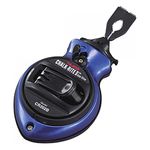
As a framing carpenter, I frequently come across a ridge span longer than the overall length of the material I’m using for the ridge. To extend the material to the correct length, I splice ridge boards with a V-shaped joint as shown in the drawing.
My crew and I call this technique “penciling the ridges,” after the big pencil-shaped piece of wood that results when the cuts are made. To begin the cuts, overlap the ridge material with the crowns pointing in the same direction. The overlap should be at least equal to the rafter spacing (usually 16 in. around here). Now take your tape and mark the rafter layout lines as shown in the drawing. Draw cutlines from the center of the top ridge board to its end, and make these cuts with the sawblade set 1/8-in. deeper than the cut. This will put saw tracks in the bottom piece, showing you where to finish the cuts.
Now you can put the pieces together with a couple of 8d nails near the end of the splice. Depending on how long the pieces are, you either can assemble them on the ground and carry them to the ridge, or put them together in place.
I like this detail because it’s clean and because it holds together better than a couple of toenailed, butt-joined boards. It’s also simpler than scabbing on a plywood gusset or a 2x splice.
—Ryan Hawks, Flagstaff, AZ
Edited and illustrated by Charles Miller
From Fine Homebuilding #124
Fine Homebuilding Recommended Products
Fine Homebuilding receives a commission for items purchased through links on this site, including Amazon Associates and other affiliate advertising programs.

Tajima Chalk Rite Chalk Line

Bluetooth Earmuffs

Roofing Gun



























View Comments
We always measure so the V-joint comes out on a rafter layout for better reinforcement of the joint. Also, as an aid in putting up the ridge board as though it were one piece we start a few 8d nails along the V-splice as Ryan has suggested but then as they are driven in we bend the nails between hammer blows with the hammer's claws. The crooked nails will travel inward in an arc; don't over do the bending or they will "fish hook" and come right back out the surface of the plank.
I used this technique with the cedar ridge boards on my patio enclosure after seeing this tip last year. I used a more obtuse angle than what was used in the tip, but it still works and looks great.
And it was fun to do. Thanks for the tip!